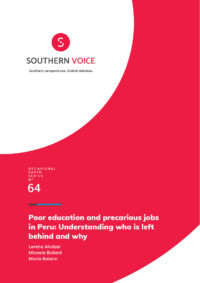Poor education and precarious jobs in Peru: understanding who is left behind and why
| Year | : | 2020 |
|---|---|---|
| Author/s | : | Lorena Alcazar, Micaela Bullard, Maria Balarin |
| Area/s | : | Education and learning, Employment, productivity and innovation |
Alcázar, L., Bullard, M., & Balarin, M. (2020). Poor education and precarious jobs in Peru: understanding who is left behind and why (Ocassional Paper Series N° 64). Southern Voice.
Given the large inequalities in Peru, fulfilling the ’leave no one behind’ UN 2030 Agenda commitment might become the country’s largest challenge to SDG implementation. In light of this, understanding who is left behind, and why, gains particular importance. This study uses a mixed methodological approach to provide a baseline of the left behind in Peru and constructs detailed profiles of the excluded. We focus on SDG 4 (quality education) and SDG 8 (decent work) to identify who are most at risk of being left behind and the factors associated with their outcomes. We then conduct synergies and trade-offs analyses to observe the impact of educational underperformance on employment conditions. Our diagnosis finds that the left behind prevalently belong to traditionally marginalised groups, such as the rural poor, women, and indigenous populations. For example, poor, rural, indigenous girls are 91% more likely to be left behind in access to quality education than their wealthier, urban, non-indigenous peers. Findings also suggest strong synergies between SDG 4 and SDG 8 for vulnerable Peruvians; being left behind in education at the ages of 12 and 15 significantly increases the probability of working precariously and being NEET at age 22. These synergies become particularly apparent when looking at gender: women were three to five times more likely to be working precariously than men with the same educational attainment.







